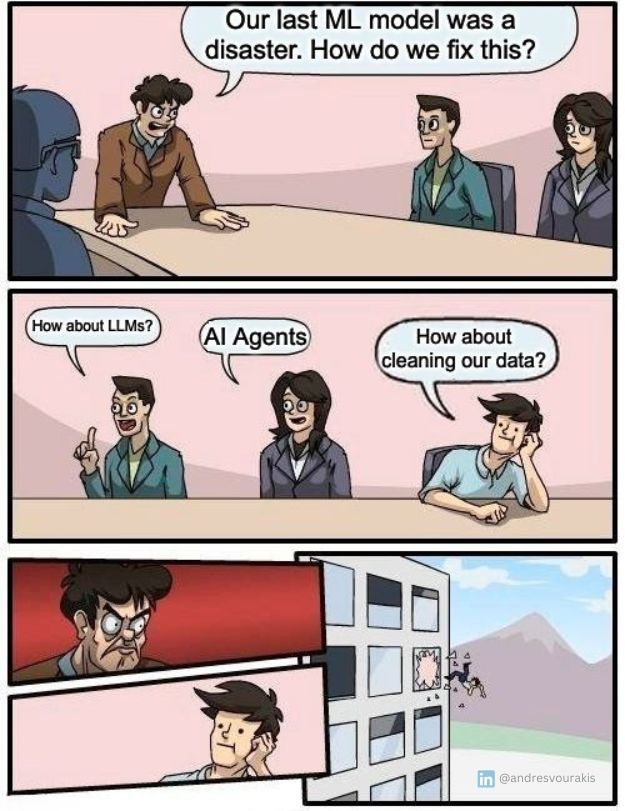The Temptation of the AI Silver Bullet

AI is having its moment. Everywhere you look, companies are rushing to implement large language models (LLMs), AI agents, and other cutting-edge techniques in hopes of solving their data problems. It’s easy to get swept up in the hype—after all, who wouldn’t want an intelligent system that magically fixes business data challenges? But there’s a fundamental issue that gets overlooked in this excitement: garbage in, garbage out (GIGO). If your underlying data is messy, unstructured, or incomplete, no amount of AI wizardry on top of this messy data can save you.
The Hard Truth: AI Is Only as Good as Your Data
The effectiveness of machine learning and AI models depends on high-quality, well-organized data. When organizations neglect data quality, they often experience issues that compound over time.
- Poor Model Performance: ML models trained on noisy, inconsistent, or incomplete data produce inaccurate or unreliable predictions.
- Increased Operational Costs: Data inconsistencies lead to rework, manual intervention, and inefficiencies, all what AI was supposed to solve for.
- Compliance and Security Risks: Inaccurate or disorganized data can result in regulatory non-compliance and security vulnerabilities.
- Loss of Trust: End users and stakeholders lose confidence when AI produced models or dashboards produce misleading or incorrect insights.
This is closely related to the common mistake of querying raw data directly without proper processing, which I covered in an earlier post. Raw data, while valuable, is often riddled with inconsistencies, duplicates, and missing context. Without proper organization and transformation, it can lead to misleading insights and unreliable AI model output.
What Is Organized Data, and Why Does It Matter?
Organized data refers to information that is structured in a way that makes it easy to process, query, and analyze—regardless of whether it’s stored in a database, a data lake, or even unstructured formats like documents and images with metadata. The key is intentional organization so that data can be effectively utilized.
Benefits of Organized Data:
- Consistency & Accuracy: Data follows clear standards, reducing ambiguity and errors.
- Efficient Processing: Well-organized data can be accessed and queried efficiently, improving retrieval speeds.
- Better Interoperability: Organized data integrates seamlessly across systems, enabling smooth data pipelines.
- Improved AI & Analytics Performance: Clean, organized data enables models to learn effectively and produce better outcomes.
Disorganized data—whether it’s stored in raw logs, loosely structured files, or mislabeled documents—should always go through some form of preprocessing before it is used in AI or analytics.
Data Quality: The Unsung Hero of AI Success
Data quality is the foundation of any successful AI or machine learning initiative. Before AI became trendy, Data quality was the reason Analytics projects would fail. The same holds true for AI use cases. Organizations should prioritize fundamental Data quality priorities:
- Standardization: Ensuring consistent data formats across sources.
- Deduplication: Removing redundant or conflicting records.
- Completeness: Filling in missing values where possible.
- Validation & Governance: Implementing rules to prevent incorrect data entry.
The Pragmatic Approach: Data First, AI Second
Instead of chasing the latest AI trends, organizations should adopt a data-first approach. This means:
- Investing in data cleaning and structuring efforts before applying AI models.
- Implementing data governance policies to maintain high-quality inputs.
- Prioritizing data-driven decision-making, rather than hype-driven experimentation.
Conclusion
While AI and machine learning can be powerful tools, they are not magic. Companies that ignore data quality and organization in favor of AI quick fixes set themselves up for failure. The best path forward is to ensure that data foundations are solid before introducing complex models. Otherwise, as the comic suggests, you might find yourself metaphorically (or literally) thrown out the window when your AI project fails.
If you found this interesting, check out my earlier post on why querying raw data directly is a bad idea—it’s another side of the same problem. So next time someone suggests fixing an AI problem with yet another AI tool, try responding with: How about organizing our data first?